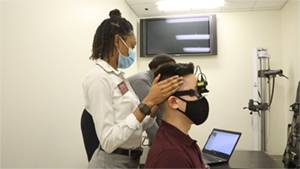Physical Therapy Lab Focuses on Accuracy and Ease of Implementing Technology

Editor's note: This article was written prior to University of the Sciences' merger with and into Saint Joseph's University and does not reflect the current, combined institution. References to programs, offices, colleges, employees, etc., may be historical information.
As technology rapidly advances, it can be difficult for clinicians to make time to learn and implement new strategies into their busy schedules. Associate Professor of Physical Therapy Anne Galgon, PT, PhD, and her team of student researchers aim to not only improve the function of technology, but also make it easier for clinicians to understand and seamlessly implement into their daily practices.
Dr. Galgon’s lab focuses on the vestibular system, which is part of the inner ear, and implementing technology to improve the way therapists examine this system.
“The vestibular system is a sensory system that tells us about head movement and head position in space.” Dr. Galgon explained. “And that's a very important reflex that allows us to see our world clearly as we move around.”
 The lab uses the Video Head Impulse Test (VHIT), which allows clinicians to measure a patient’s head and eye movements and track the data to better understand exactly what is happening, rather than relying on just a visual examination.
The lab uses the Video Head Impulse Test (VHIT), which allows clinicians to measure a patient’s head and eye movements and track the data to better understand exactly what is happening, rather than relying on just a visual examination.
“The VHIT is a device that we can use as clinicians in order to measure the vestibular ocular reflex,” explained Phillip Chen '22 (DPT) a student researcher in Dr. Galgon’s lab. “As clinicians we normally do a manual hit where we physically rotate the head of the patient. However with this technology we are able to use it to quantify the information rather than it being subjective which can lead to a lot of interpreter errors.”
While each student working in the lab has their own reasons for being interested in vestibular research, DeJ’a Crippen '22 (DPT) has a personal connection to the topic. Crippen’s grandmother lives with vertigo, a form of severe dizziness which is typically caused by disease affecting the vestibular system.
Crippen has chosen to base her research and future career around helping those affected by vertigo, starting with her grandmother.
“When I figured out that Dr. Galgon was the queen of vestibular rehabilitation, I knew I had to work in this lab and actually assist her,” Crippen shared.
The ultimate goal of this lab’s research is not only to measure the accuracy of the VHIT, but to also create an efficient system for clinicians to adopt this technology.
"Training shouldn't be a barrier to using technology"
Anne Galgon, PT, PhD
“A barrier to adopting a technology is learning how to use it. If a clinician tries to use a technology and it’s not successful, they're going to say ‘oh I’m too busy to learn’, so we’re trying to quantify how much practice and what type of feedback is needed to help them,” Dr. Galgon shared. “Training shouldn’t be a barrier to using technology.”
Working with clinicians of all levels allows this research team to create a complete picture for how to efficiently operate and integrate the VHIT system.
Nijiera Addison '22 (DPT) a student on Dr. Galgon’s research team, explained, “Figuring out the accuracy of [the VHIT] between novice clinicians and expert clinicians can really hone in on vestibular rehabilitation research. We’re trying to use the VHIT to see how we can better vestibular rehabilitation and physical therapy as a whole.”
